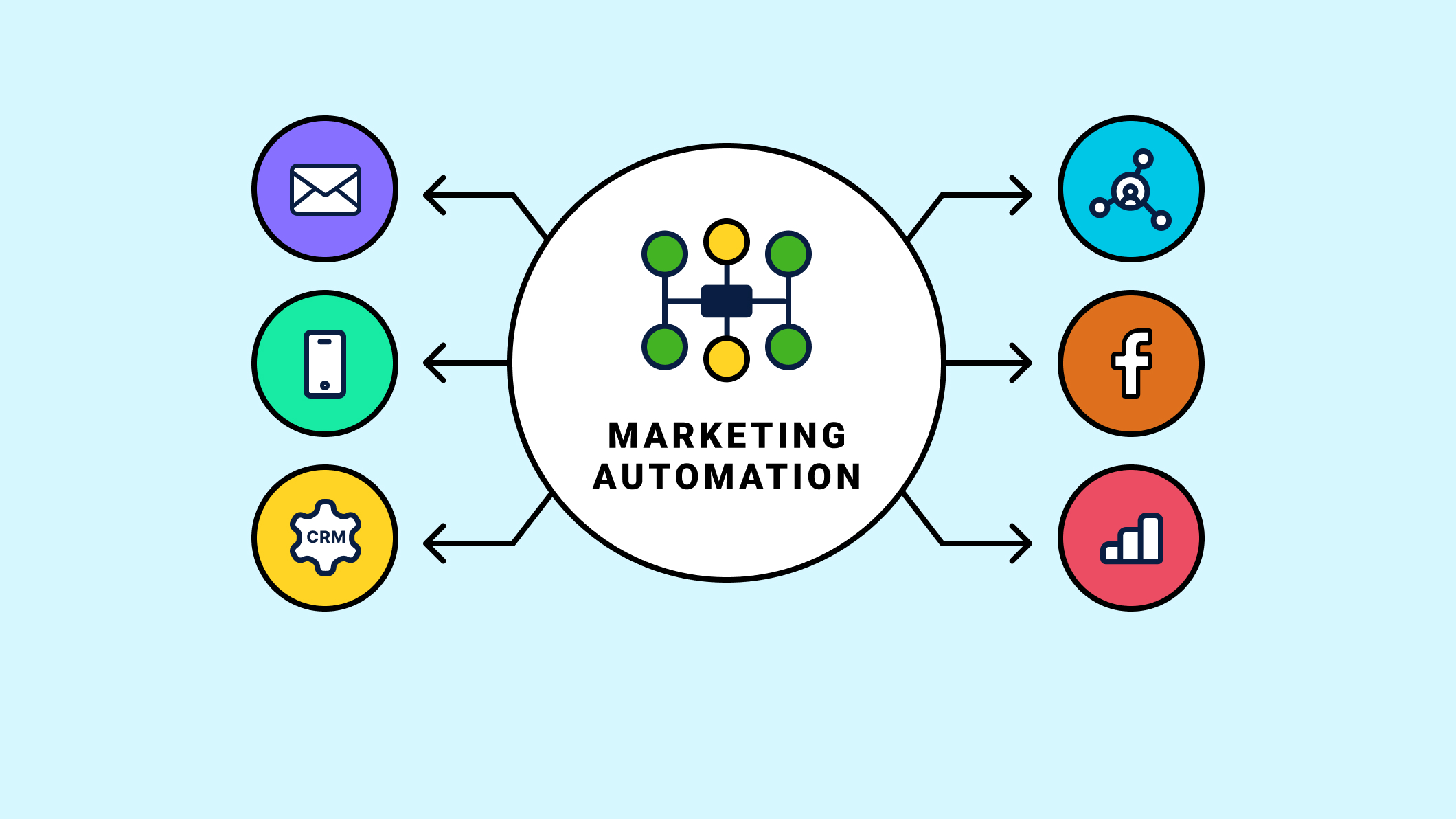Email marketing vs marketing automation are two of the most popular and effective digital marketing strategies today. What are they, and what sets them apart? Which one is better for your business goals and needs? In this article, we will compare and contrast email marketing and marketing automation, and help you decide which one is right for you.
 Email marketing is a great way to reach customers without spending much money. For every dollar you invest, you can make around $42. Getting started is simple – you just need an email service provider and a list of contacts. Plus, you can keep track of how well your emails are doing, like how many people open them or click on links.
Yet, email marketing comes with certain drawbacks, including:
– Spam and deliverability issues: Your emails may end up in the spam folder or get blocked by the email service providers, which can affect your reputation and reach.
– Limited functionality and integration: Your email service provider may not offer all the features and tools you need, or may not integrate well with your other marketing platforms and systems.
– Time-consuming and labor-intensive: You may need to spend a lot of time and effort to create, send, and optimize your email campaigns, especially if you have a large and diverse list of contacts.
– Risk of losing subscribers and damaging reputation: Your subscribers may unsubscribe from your list or mark your emails as spam if they find them irrelevant, annoying, or intrusive.
Email marketing is a great way to reach customers without spending much money. For every dollar you invest, you can make around $42. Getting started is simple – you just need an email service provider and a list of contacts. Plus, you can keep track of how well your emails are doing, like how many people open them or click on links.
Yet, email marketing comes with certain drawbacks, including:
– Spam and deliverability issues: Your emails may end up in the spam folder or get blocked by the email service providers, which can affect your reputation and reach.
– Limited functionality and integration: Your email service provider may not offer all the features and tools you need, or may not integrate well with your other marketing platforms and systems.
– Time-consuming and labor-intensive: You may need to spend a lot of time and effort to create, send, and optimize your email campaigns, especially if you have a large and diverse list of contacts.
– Risk of losing subscribers and damaging reputation: Your subscribers may unsubscribe from your list or mark your emails as spam if they find them irrelevant, annoying, or intrusive.
 Using marketing automation can make your work easier and faster by doing repetitive tasks automatically. It can also make customers happier by giving them useful information and deals. Additionally, it can help you find the best potential customers and turn them into sales. Lastly, it can give you lots of data to understand your marketing better.
However, marketing automation also has some challenges, such as:
– High cost and complexity: Marketing automation software and tools can be expensive and complicated to implement and maintain, especially for small and medium-sized businesses.
– Technical and operational challenges: You may need to have the technical skills and knowledge to use and troubleshoot the marketing automation software and tools, or hire someone who does.
– Lack of human touch and creativity: You may lose the personal and emotional connection with your audience if you rely too much on automation and forget to add some human and creative elements to your marketing campaigns.
– Risk of over-automation and alienation: You may annoy and alienate your audience if you send them too many or irrelevant messages, or if you fail to respect their privacy and preferences.
Using marketing automation can make your work easier and faster by doing repetitive tasks automatically. It can also make customers happier by giving them useful information and deals. Additionally, it can help you find the best potential customers and turn them into sales. Lastly, it can give you lots of data to understand your marketing better.
However, marketing automation also has some challenges, such as:
– High cost and complexity: Marketing automation software and tools can be expensive and complicated to implement and maintain, especially for small and medium-sized businesses.
– Technical and operational challenges: You may need to have the technical skills and knowledge to use and troubleshoot the marketing automation software and tools, or hire someone who does.
– Lack of human touch and creativity: You may lose the personal and emotional connection with your audience if you rely too much on automation and forget to add some human and creative elements to your marketing campaigns.
– Risk of over-automation and alienation: You may annoy and alienate your audience if you send them too many or irrelevant messages, or if you fail to respect their privacy and preferences.
What is Email Marketing?
Email marketing involves sending personalized messages to a group of subscribers through email. Its goal is to build relationships, improve conversions, and enhance loyalty. With email marketing, you can directly connect with your audience and customize messages according to their actions and preferences: – Welcome new subscribers and customers – Share knowledge and details about your products or services with your audience – Promote your offers and discounts – Nurture and follow up with your leads – Request feedback and reviews – Re-engage and retain your customers Email marketing is a great way to reach customers without spending much money. For every dollar you invest, you can make around $42. Getting started is simple – you just need an email service provider and a list of contacts. Plus, you can keep track of how well your emails are doing, like how many people open them or click on links.
Yet, email marketing comes with certain drawbacks, including:
– Spam and deliverability issues: Your emails may end up in the spam folder or get blocked by the email service providers, which can affect your reputation and reach.
– Limited functionality and integration: Your email service provider may not offer all the features and tools you need, or may not integrate well with your other marketing platforms and systems.
– Time-consuming and labor-intensive: You may need to spend a lot of time and effort to create, send, and optimize your email campaigns, especially if you have a large and diverse list of contacts.
– Risk of losing subscribers and damaging reputation: Your subscribers may unsubscribe from your list or mark your emails as spam if they find them irrelevant, annoying, or intrusive.
Email marketing is a great way to reach customers without spending much money. For every dollar you invest, you can make around $42. Getting started is simple – you just need an email service provider and a list of contacts. Plus, you can keep track of how well your emails are doing, like how many people open them or click on links.
Yet, email marketing comes with certain drawbacks, including:
– Spam and deliverability issues: Your emails may end up in the spam folder or get blocked by the email service providers, which can affect your reputation and reach.
– Limited functionality and integration: Your email service provider may not offer all the features and tools you need, or may not integrate well with your other marketing platforms and systems.
– Time-consuming and labor-intensive: You may need to spend a lot of time and effort to create, send, and optimize your email campaigns, especially if you have a large and diverse list of contacts.
– Risk of losing subscribers and damaging reputation: Your subscribers may unsubscribe from your list or mark your emails as spam if they find them irrelevant, annoying, or intrusive.
What is Marketing Automation?
Marketing automation involves using software and tools to make marketing tasks easier. These tasks include sending emails, finding potential customers, nurturing those leads, scoring them, and using social media for marketing. With marketing automation, you can run complex campaigns and send tailored messages to specific people when they’re most likely to engage: – Generate and capture more qualified leads – Segment and target your audience based on their profile and behavior – Send personalized and timely messages across multiple channels – Nurture and move your leads through the sales funnel – Increase your conversion rate and revenue – Evaluate and enhance your marketing effectiveness and return on investment (ROI). Using marketing automation can make your work easier and faster by doing repetitive tasks automatically. It can also make customers happier by giving them useful information and deals. Additionally, it can help you find the best potential customers and turn them into sales. Lastly, it can give you lots of data to understand your marketing better.
However, marketing automation also has some challenges, such as:
– High cost and complexity: Marketing automation software and tools can be expensive and complicated to implement and maintain, especially for small and medium-sized businesses.
– Technical and operational challenges: You may need to have the technical skills and knowledge to use and troubleshoot the marketing automation software and tools, or hire someone who does.
– Lack of human touch and creativity: You may lose the personal and emotional connection with your audience if you rely too much on automation and forget to add some human and creative elements to your marketing campaigns.
– Risk of over-automation and alienation: You may annoy and alienate your audience if you send them too many or irrelevant messages, or if you fail to respect their privacy and preferences.
Using marketing automation can make your work easier and faster by doing repetitive tasks automatically. It can also make customers happier by giving them useful information and deals. Additionally, it can help you find the best potential customers and turn them into sales. Lastly, it can give you lots of data to understand your marketing better.
However, marketing automation also has some challenges, such as:
– High cost and complexity: Marketing automation software and tools can be expensive and complicated to implement and maintain, especially for small and medium-sized businesses.
– Technical and operational challenges: You may need to have the technical skills and knowledge to use and troubleshoot the marketing automation software and tools, or hire someone who does.
– Lack of human touch and creativity: You may lose the personal and emotional connection with your audience if you rely too much on automation and forget to add some human and creative elements to your marketing campaigns.
– Risk of over-automation and alienation: You may annoy and alienate your audience if you send them too many or irrelevant messages, or if you fail to respect their privacy and preferences.





